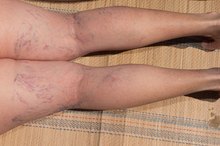Causes of Poor Circulation in Feet & Hands
Poor circulation occurs when there is not enough blood supplied to an area to meet the needs of the cells. Poor circulation to the hands and feet causes symptoms such as the sensation of tingling or numbness, cramping and the feeling of coldness in the fingers and toes. The circulatory system functions to carry blood and transport water, oxygen and nutrients to the cells of the body. Conditions and diseases that inhibit blood flow cause poor circulation in the hands and feet.
If you are experiencing serious medical symptoms, seek emergency treatment immediately.
Peripheral Vascular Disease
Peripheral vascular disease, PVD, occurs when the arteries or veins in the body become blocked 2. The most common form of PVD is peripheral artery disease, which affects approximately 12 percent to 20 percent of the 65 years or older population, according to the American Heart Association 123. PAD occurs when the arteries, which are the blood vessels that carry blood away from the heart to supply the cells of the body, in the legs become blocked.
Arteries usually have smooth walls allowing blood to flow freely. Over time, a substance known as plaque, which consists of cholesterol, calcium and fibrous tissue, builds up in the arteries. As plaque continues to build, a condition known as atherosclerosis, blood flow is inhibited. The poor circulation that results from PAD and other PVD diseases causes leg or arm pain, wounds on the feet or hands that will not heal and a noticeable decrease in temperature of the lower leg and feet or hands.
- Peripheral vascular disease, PVD, occurs when the arteries or veins in the body become blocked 2.
- Over time, a substance known as plaque, which consists of cholesterol, calcium and fibrous tissue, builds up in the arteries.
Heart Disease
How to Care for the Circulatory System
Learn More
Heart disease represents a group of diseases that affects the heart and blood vessels 3. As the No. 1 cause of death among men and women in the United States, according to the doctors at the Mayo Clinic, heart disease remains one of the main causes of circulatory problems 3.
Arrhythmias, one form of heart disease, cause an irregular heartbeat, too fast or too slow 3. A heart that beats too fast works ineffectively as blood can be left in the heart resulting in less blood flowing through the blood vessels. A heart that beats too slowly is not able to pump enough blood to meet the needs of the cells. Both of these conditions can cause poor circulation.
A heart attack occurs when the blood supply to the heart is blocked, resulting in damage to the heart muscle. A damaged heart pumps an inadequate supply of blood through the body resulting in poor circulation.
- Heart disease represents a group of diseases that affects the heart and blood vessels 3.
- A heart that beats too fast works ineffectively as blood can be left in the heart resulting in less blood flowing through the blood vessels.
Raynaud's Syndrome
Raynaud’s syndrome occurs when the arteries leading to the fingers and toes react to outside stimuli, such as cold temperatures or stress, by constricting, also known as a vasospasm 4. The vessels narrow restricting the flow of blood to the fingers and toes resulting in sensations of coldness, burning pain, numbness and tingling. The fingers and toes often turn blue due to the poor circulation. Raynaud’s syndrome is the primary disease in approximately 80 percent of the cases, according to the Merck Manual 4. Other conditions, such as scleroderma, cause the remaining 20 percent, known as secondary Raynaud’s syndrome 4.
Related Articles
References
- American Heart Association: Peripheral Artery Disease
- Society for Vascular Surgery: Peripheral Artery Disease
- The Mayo Clinic: Heart Disease
- The Merck Manual: Raynaud’s Syndrome
- American Heart Association. What is Cardiovascular Disease?. Updated May 31, 2017.
- Centers for Disease Control and Prevention. Heart Disease Facts. Updated November 28, 2017.
- American Heart Association. About Peripheral Artery Disease (PAD). Updated October 31, 2016.
- Harvard Heart Letter. When an Infection Attacks the Heart. Harvard Health Publishing. Harvard Medical School. Published July 2016.
- American Heart Association. Symptoms, Diagnosis and Monitoring of Arrhythmia. Updated October 23, 2014.
- American Heart Association. Non-Invasive Tests and Procedures. Updated July 31, 2015.
- American Heart Association. Cardiac Medications. Updated July 31, 2015,
- Leening MJ, Berry JD, Allen NB. Lifetime Perspectives on Primary Prevention of Atherosclerotic Cardiovascular Disease. JAMA. April 12, 2016;315(14):1449-50. doi:10.1001/jama.2016.1654
- Wigley F., and N. Flavahan. Raynaud's Phenomenon. The New England Journal of Medicine. 2016. 375(6):556-65. doi:10.1056/NEJMra1507638
- National Heart, Lung, and Blood Institute. Raynaud's. October 2019.
- Maverakis, E., Patel, F., Kronenberg, D. et al. International Consensus Criteria for the Diagnosis of Raynaud's Phenomenon. Journal of Autoimmunity. 2014. 48-49:60-65. doi:10.1016/j.jaut.2014.01.020
- Scleroderma Foundation. Systemic Sclerosis: Diffuse and Limited (PDF). Published January 2019.
- Herrick, A. Evidence-Based Management of Raynaud's Phenomenon. Therapeutic Advances in Musculoskeletal Diseases. 2017. 9(12):317-329. doi:10.1177/1759720X17740074
- Khouri C, Blaise S, Carpentier P, Villier C, Cracowski JL, Roustit M. Drug-induced Raynaud's phenomenon: beyond β-adrenoceptor blockers. Br J Clin Pharmacol. 2016;82(1):6–16. doi:10.1111/bcp.12912
- U.S. Department of Justice. A Guide To Disability Rights Laws. U.S. Department of Justice Civil Rights Division - Disability Rights Section. Published July 2009.
- Wigley F, Post T (ed). Treatment Of Raynaud Phenomenon: Initial Management. Updated December 2019
- Rinash, F., Tingey, P., Hardy, S. et al. Calcium Channel Blockers for Primary and Secondary Raynaud's Phenomenon. Cochrane Database of Systematic Reviews. 2017.12:CD000467. doi:10.1002/14651858.CD000467.pub2
- Qiu, O., Chan, T., Luen, M., Cruz, J., and E. Hermes-De Santis. Use of Nitroglycerine Ointment to Treat Primary and Secondary Raynaud's Phenomenon: A Systematic Literature Review. Rheumatology International. 2018 Aug 22. doi:10.1007/s00296-018-4119-9
- The Raynaud’s Association. Frequently Asked Questions. Updated July 2019.
- Choi, W., Choi, C., Kim, K. et al. To compare the efficacy and safety of nifedipine sustained release with Ginkgo biloba extract to treat patients with primary Raynaud’s phenomenon in South Korea; Korean Raynaud study (KOARA study). Clin Rheumatol 28, 553 (2009) doi:10.1007/s10067-008-1084-9
- Arthritis Foundation. Raynaud’s Phenomenon. Updated September 2019.
- Sufka P. Raynaud’s Phenomenon. American College of Rheumatology. Updated March 2019.
Writer Bio
Stephanie Chandler is a freelance writer whose master's degree in biomedical science and over 15 years experience in the scientific and pharmaceutical professions provide her with the knowledge to contribute to health topics. Chandler has been writing for corporations and small businesses since 1991. In addition to writing scientific papers and procedures, her articles are published on Overstock.com and other websites.








